ReactJS is a component-based JavaScript library used to build dynamic and interactive user interfaces.
components are the building blocks of a React application
A component is essentially a reusable, self-contained piece of UI.
React allows you to break down a complex UI into smaller, manageable pieces
React offers two main types of components: functional components and class components.
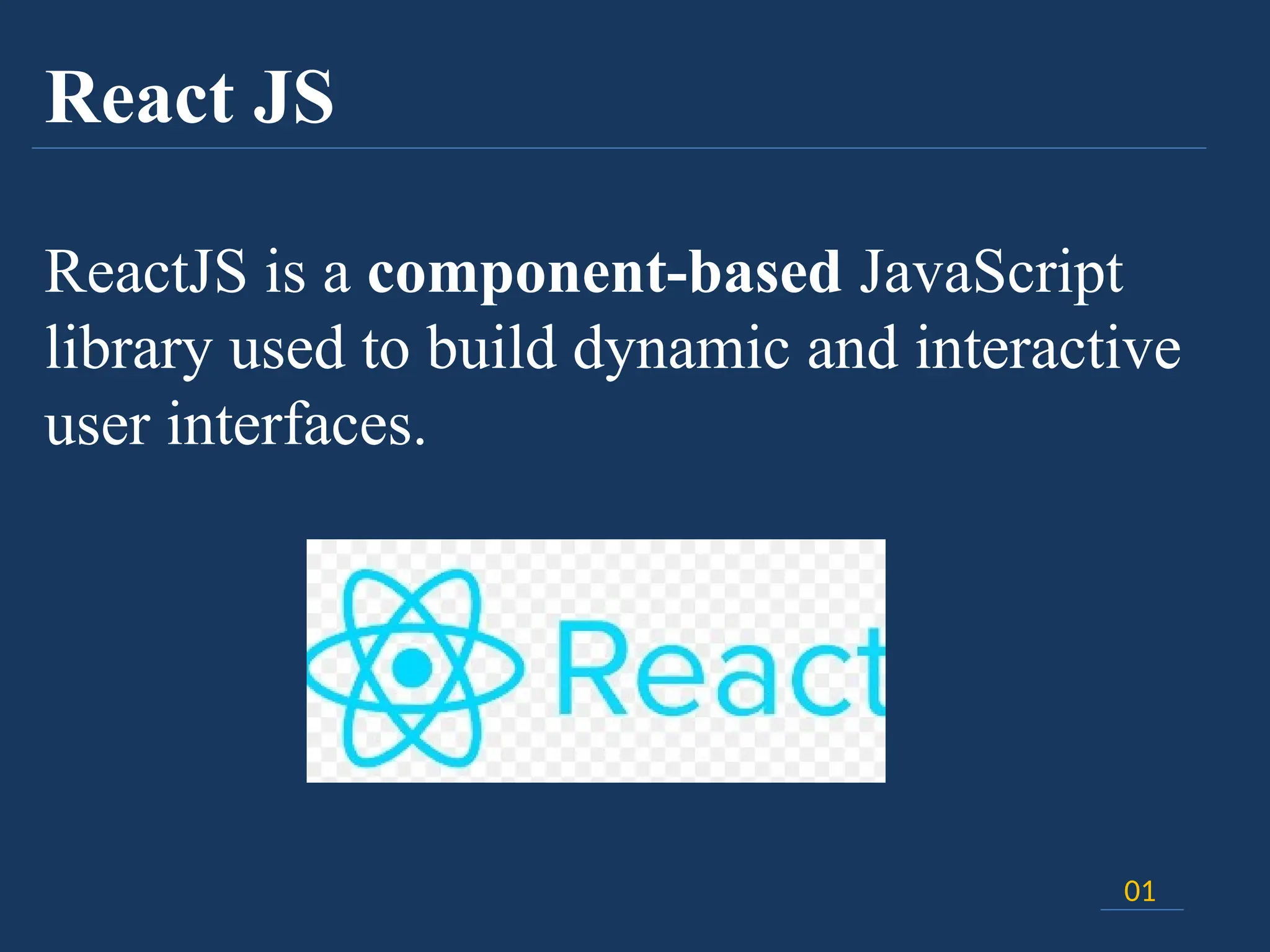
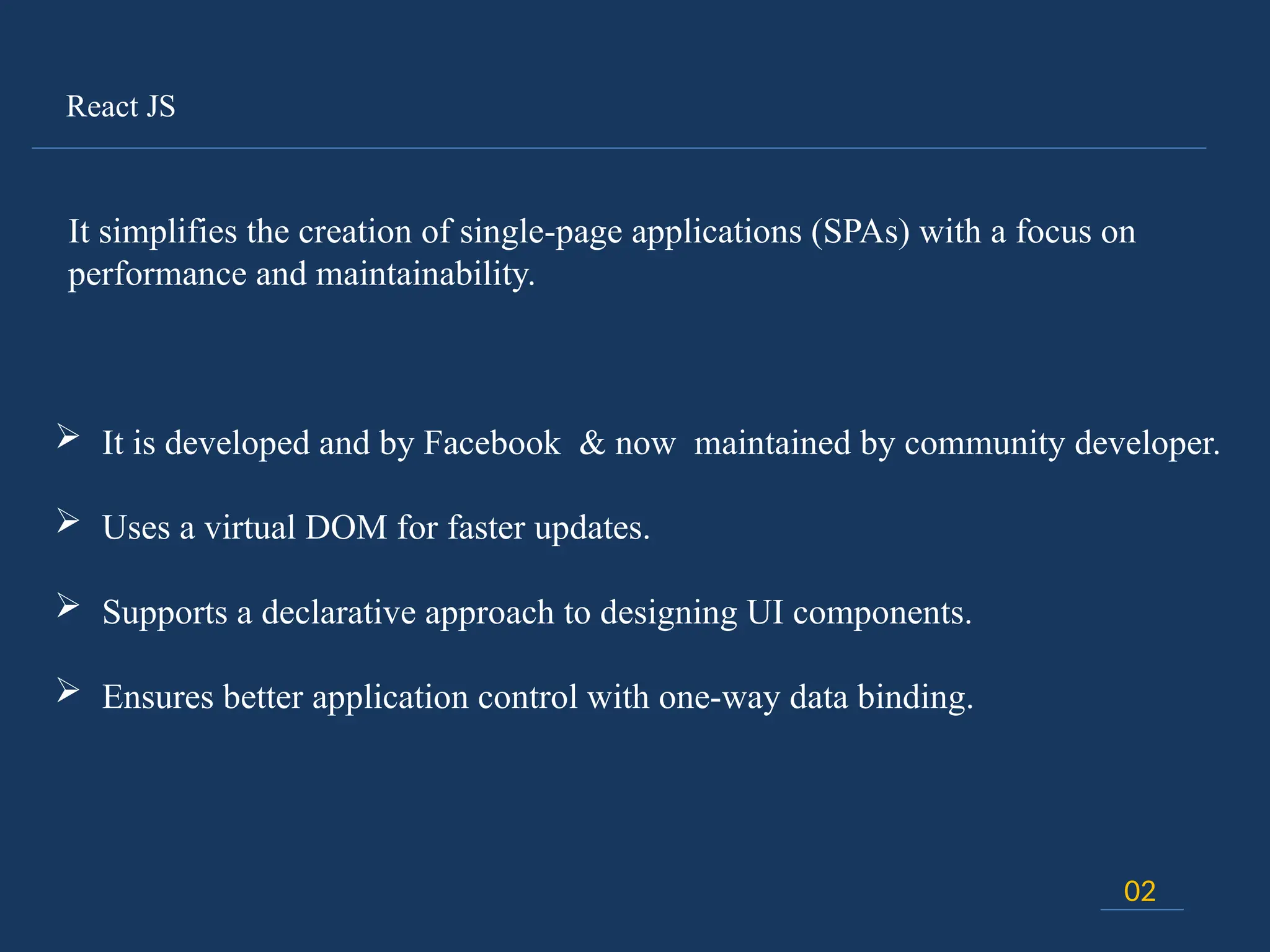
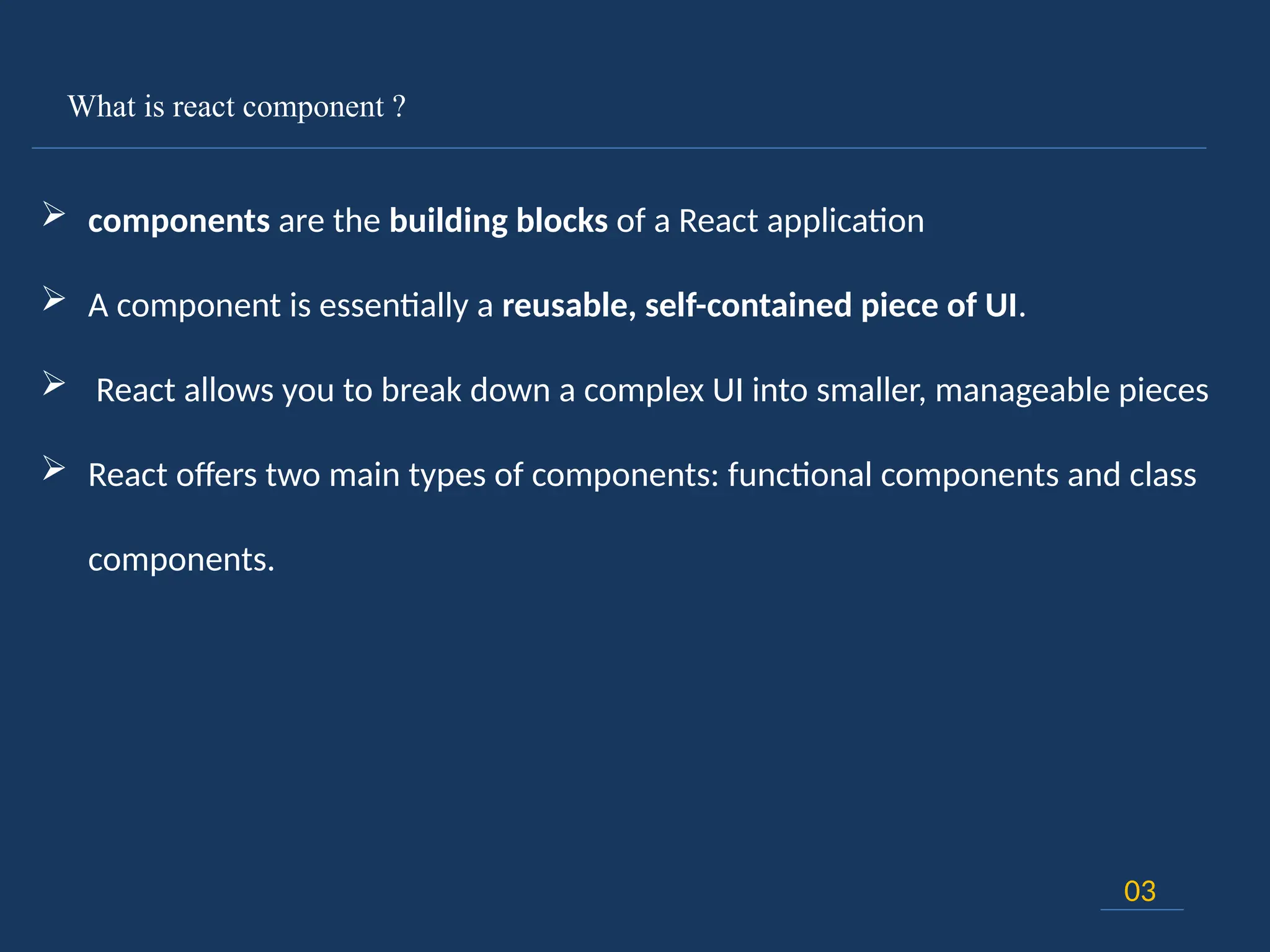

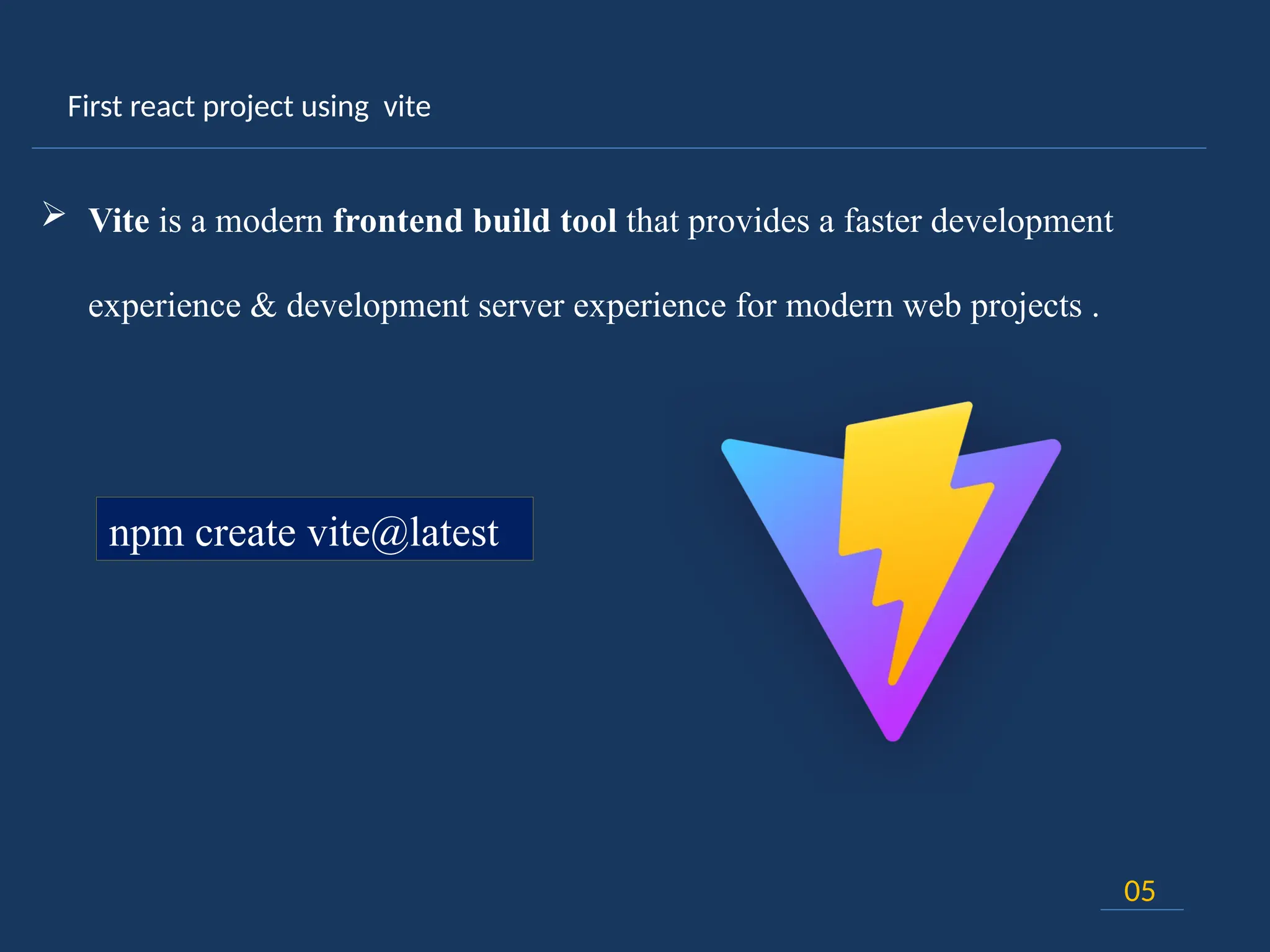
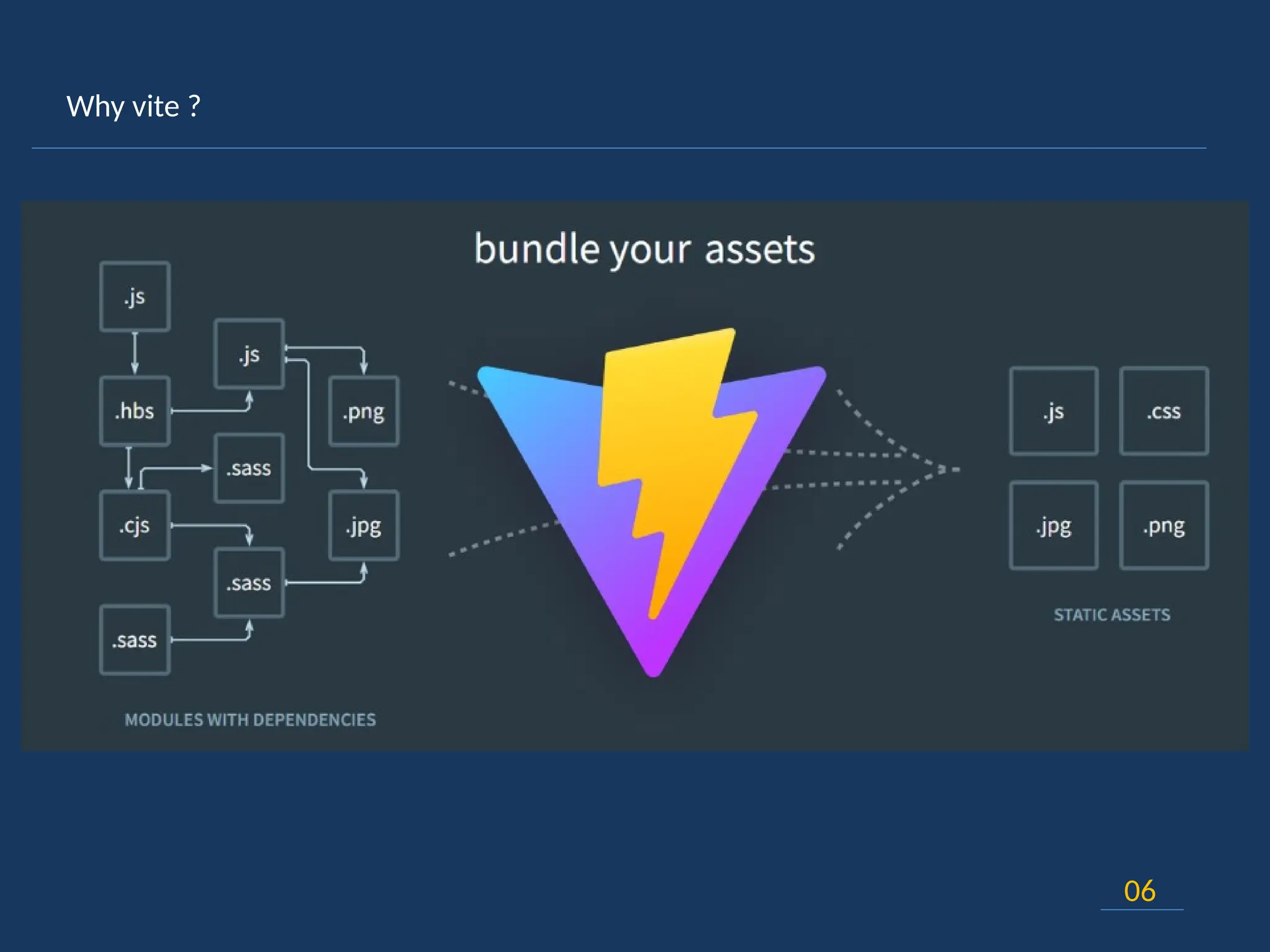
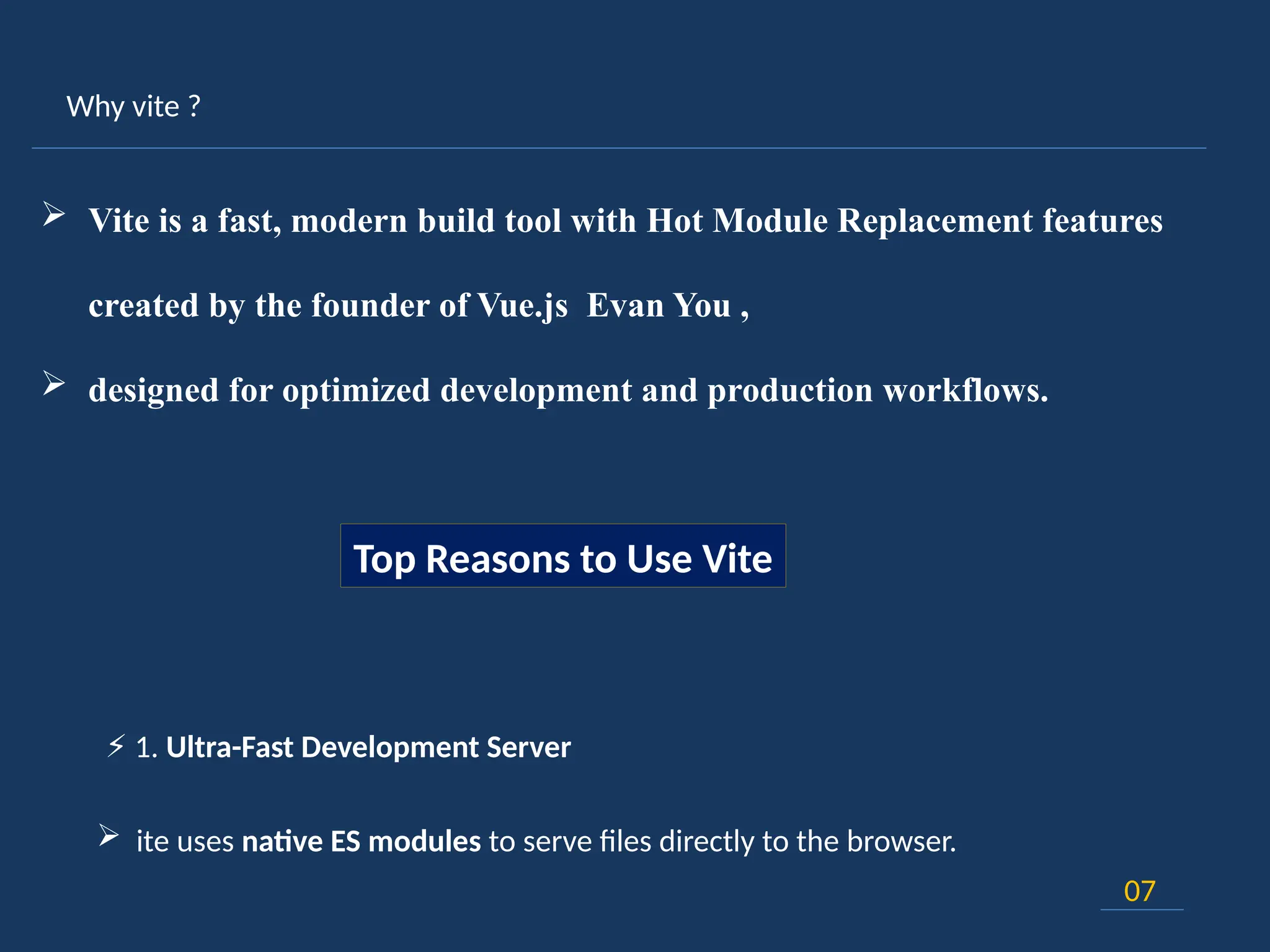
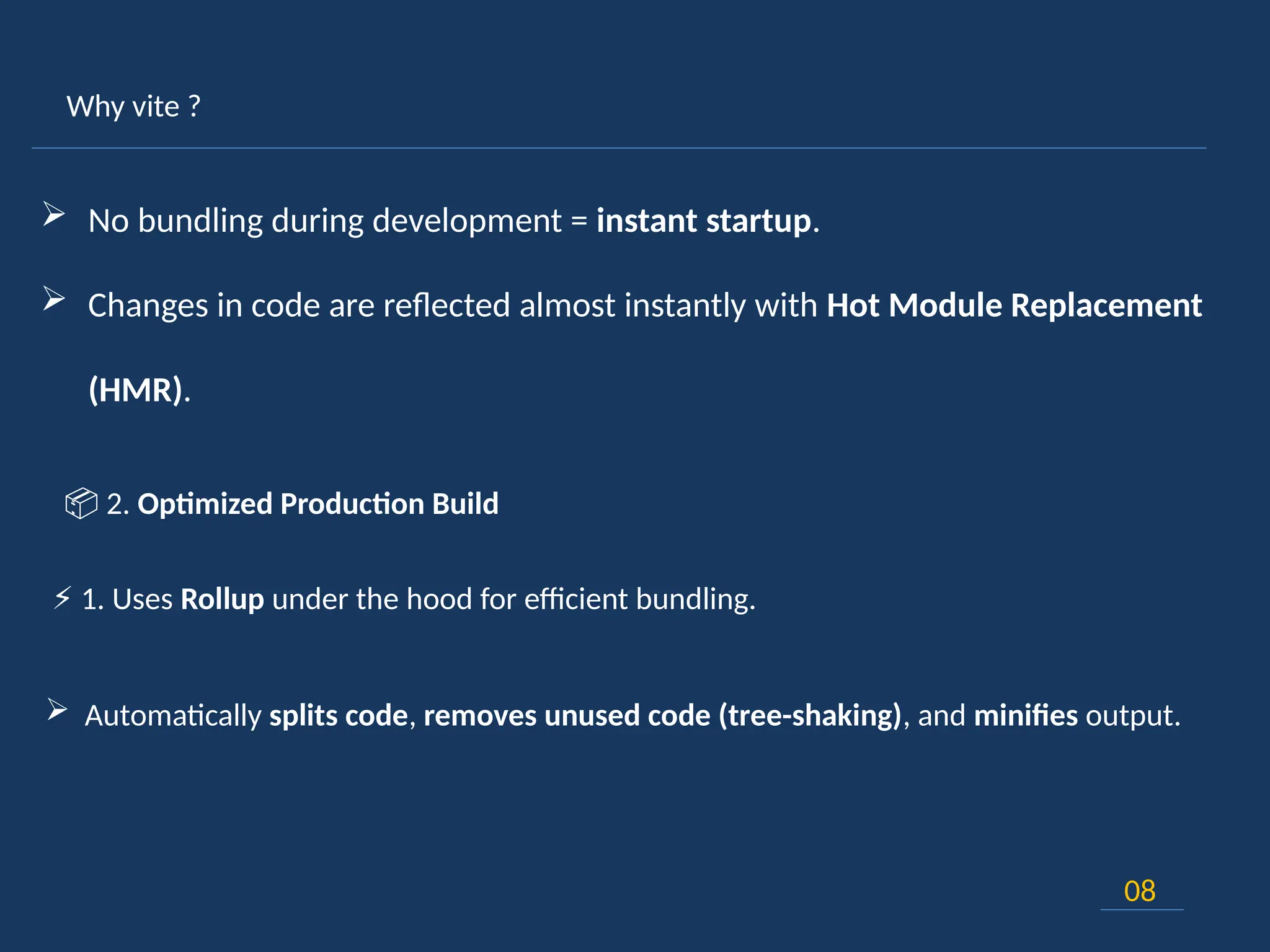
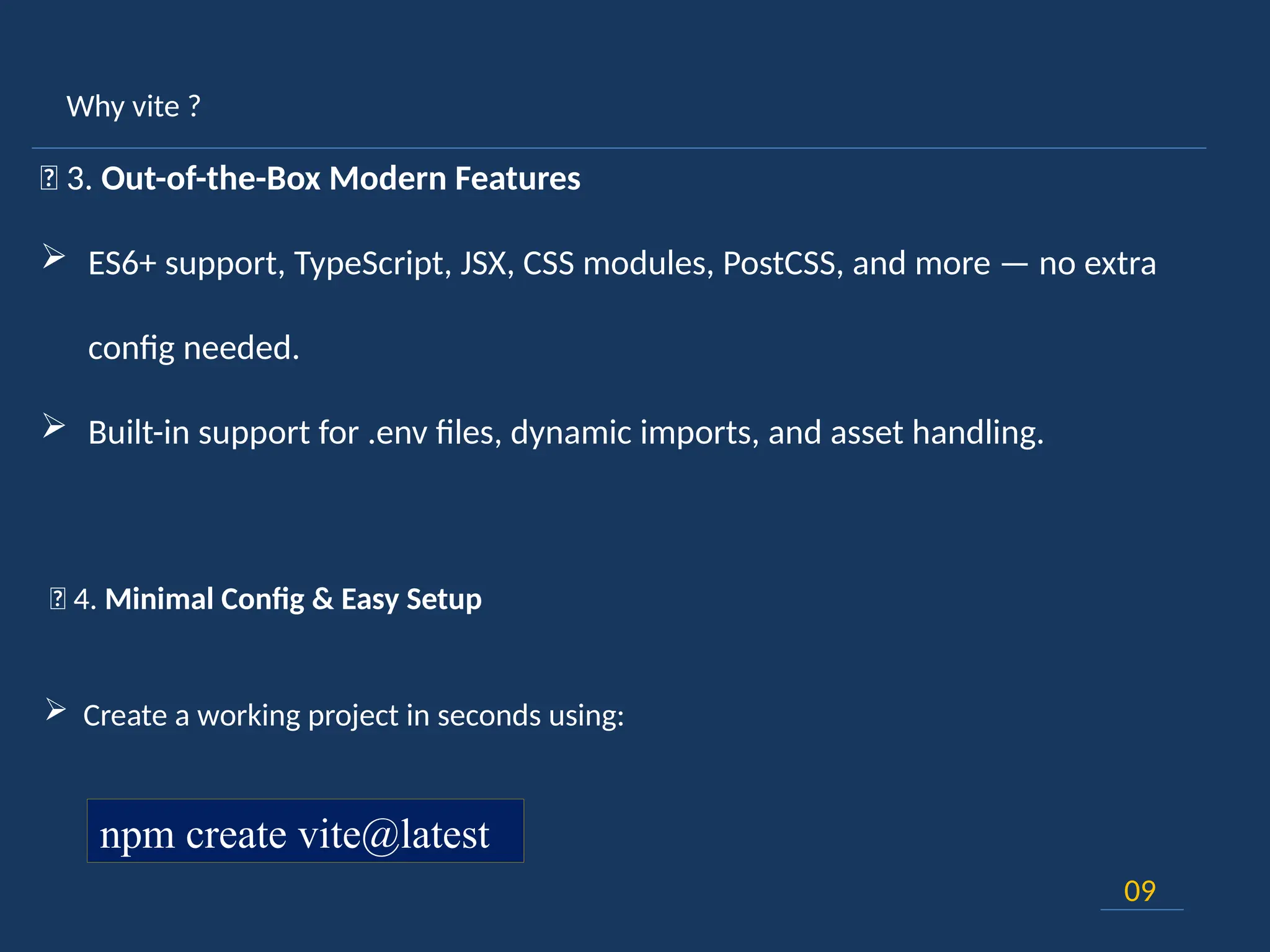
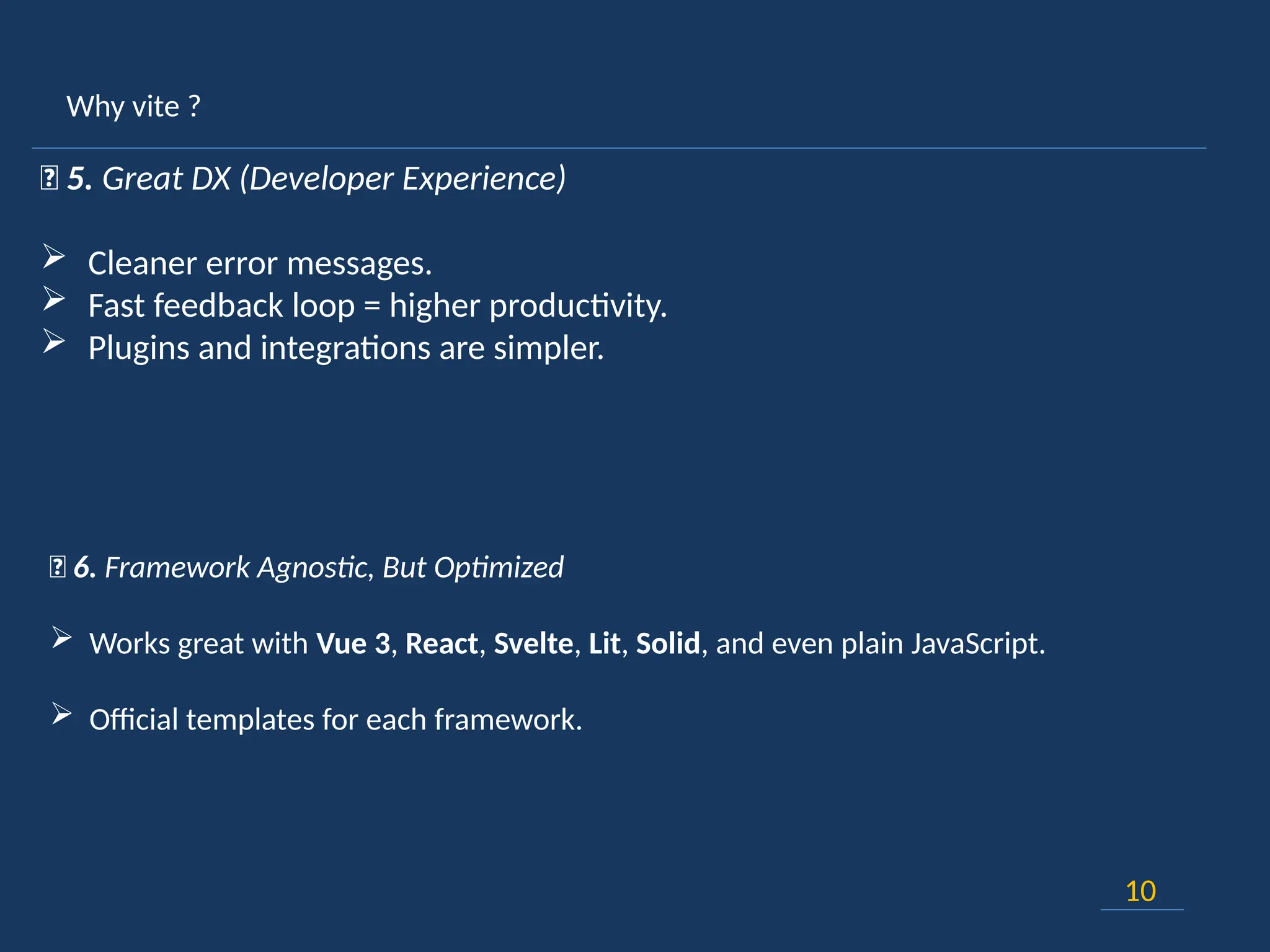
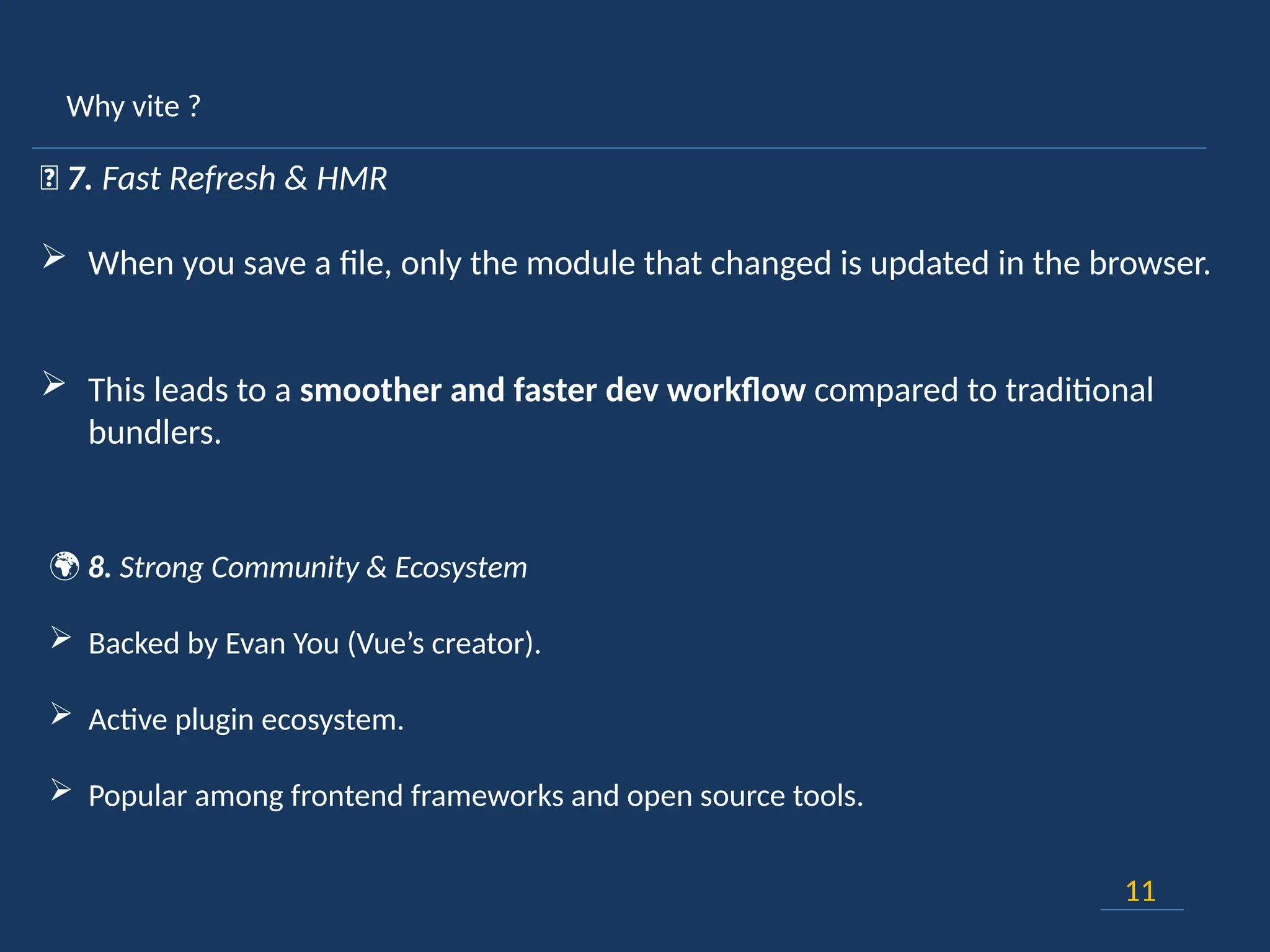
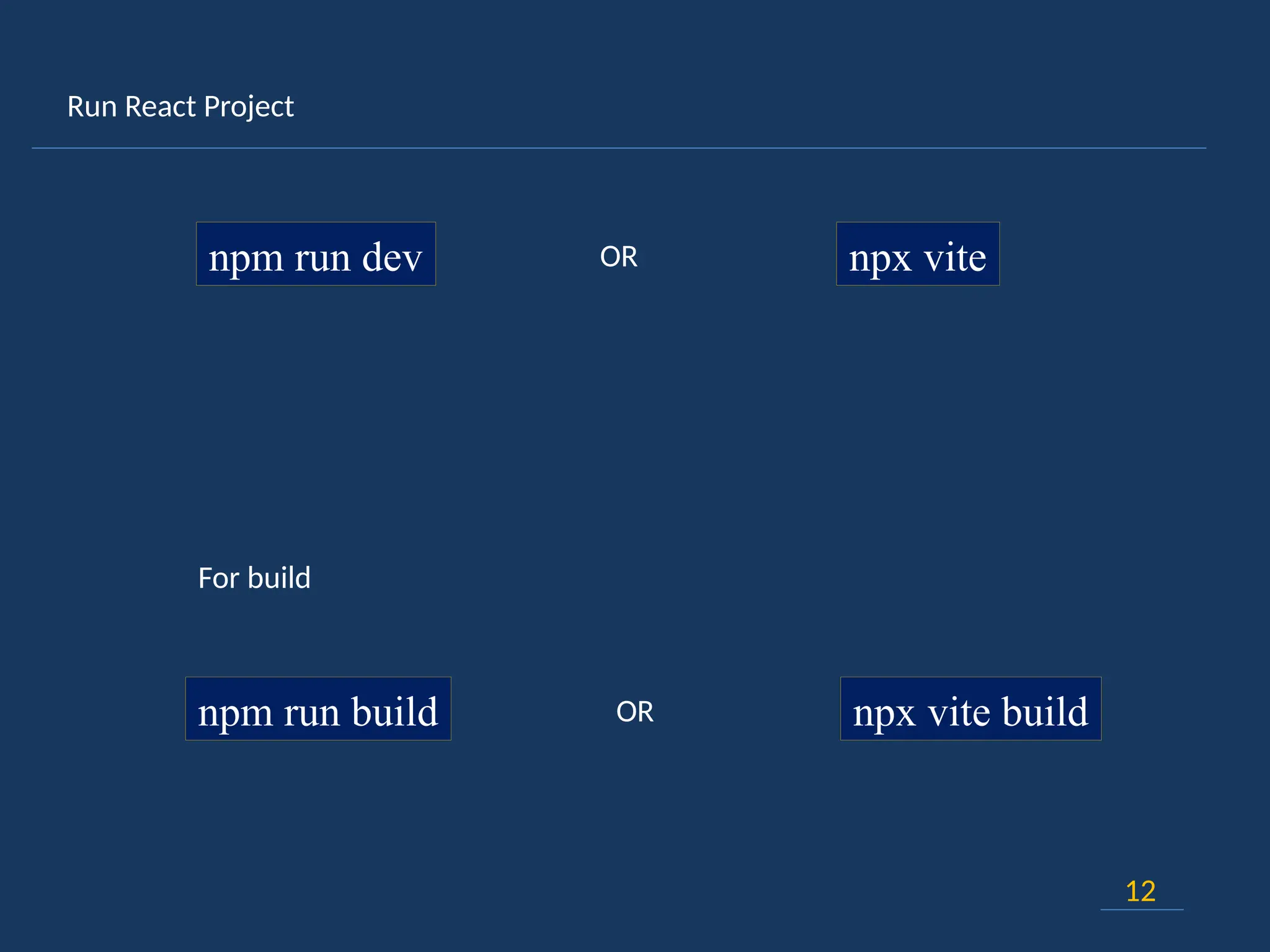
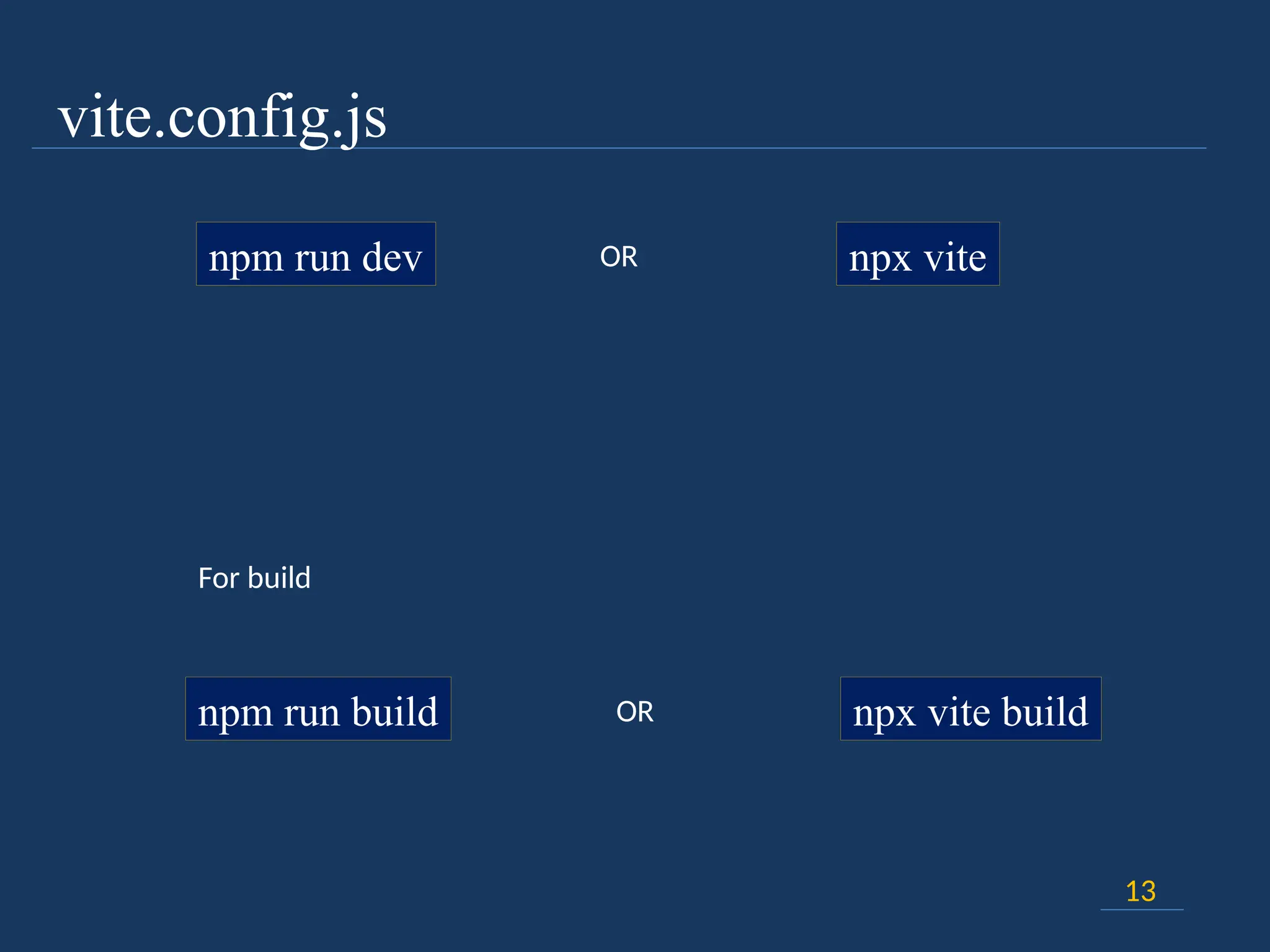
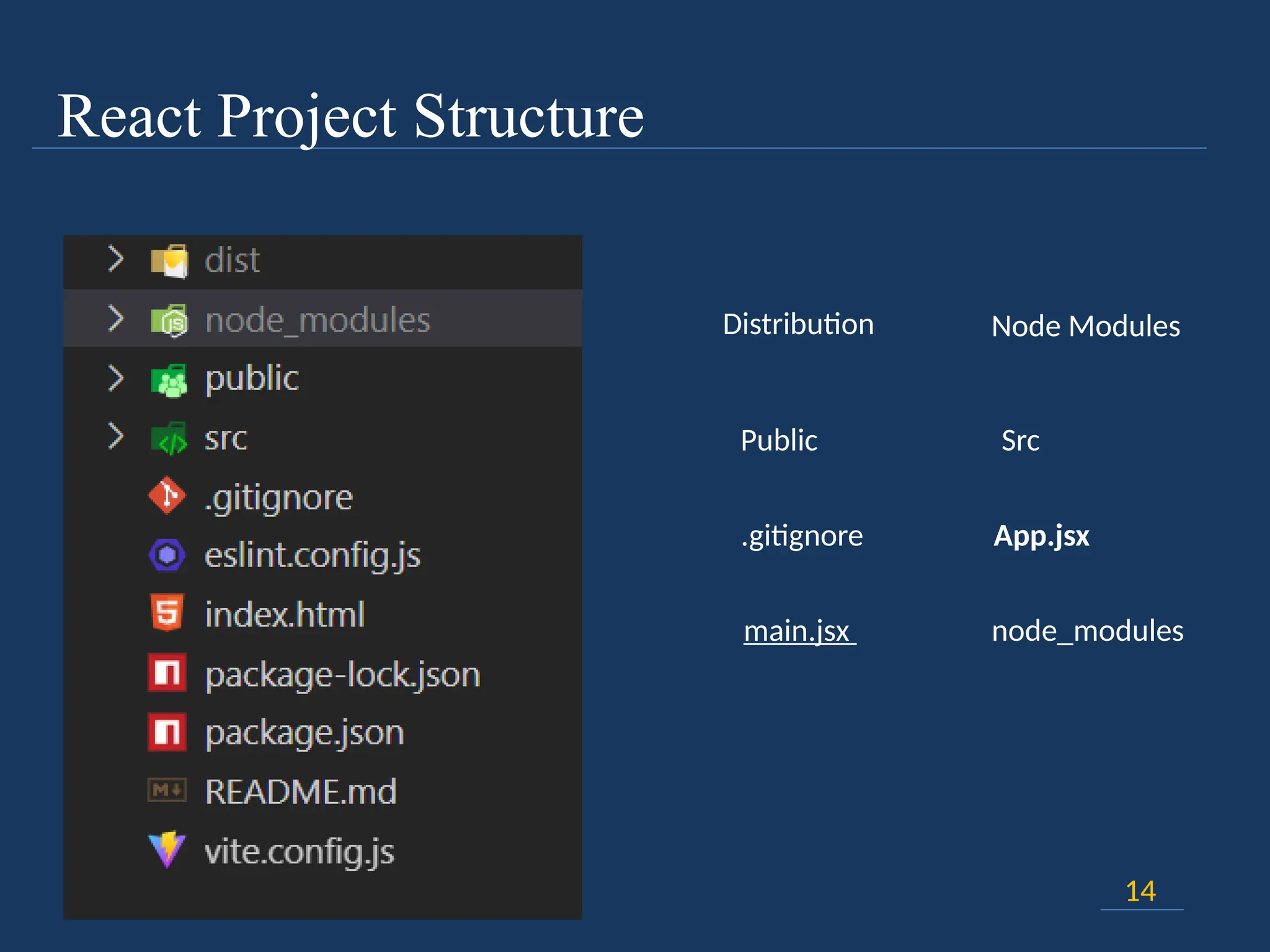
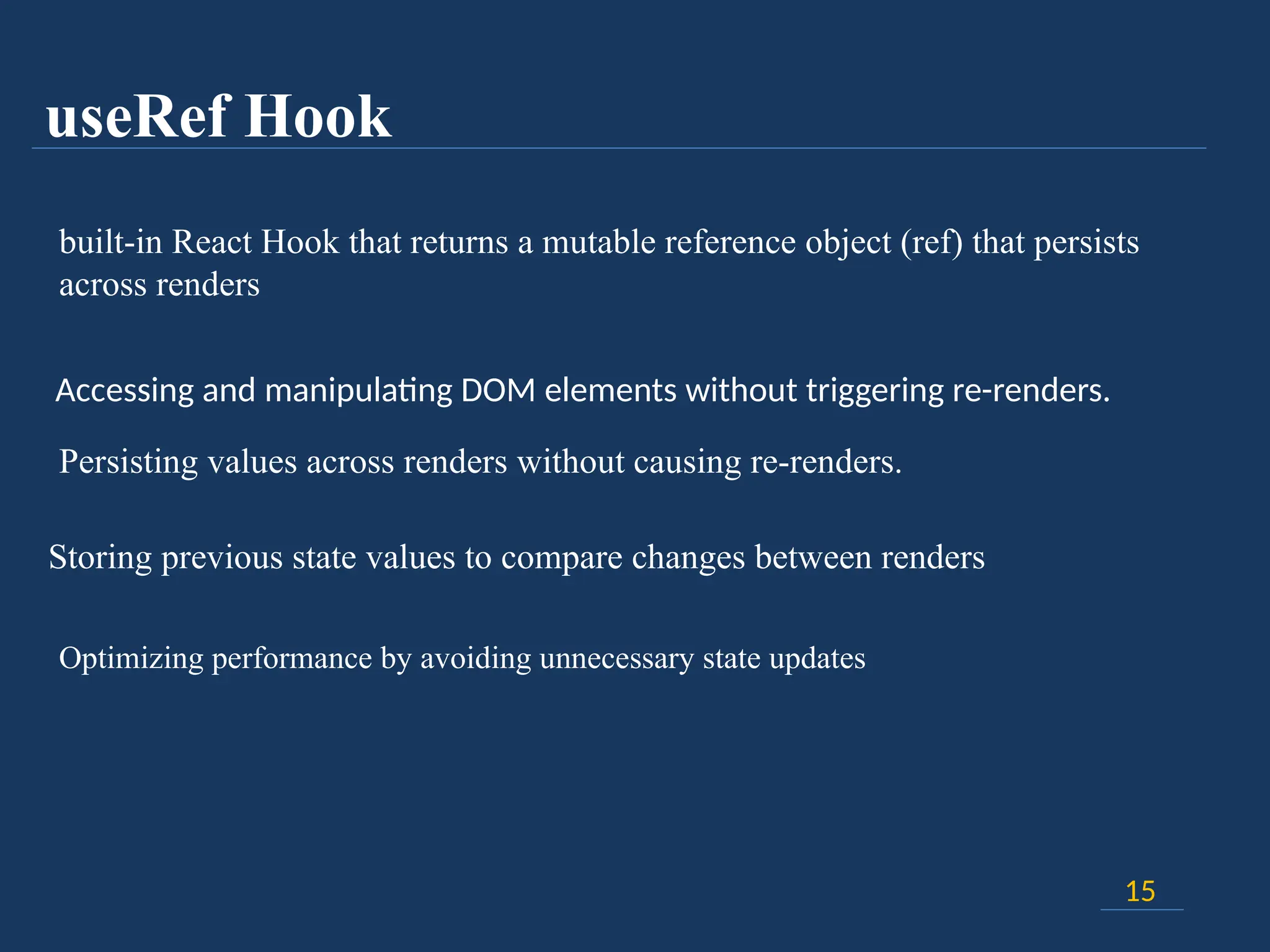
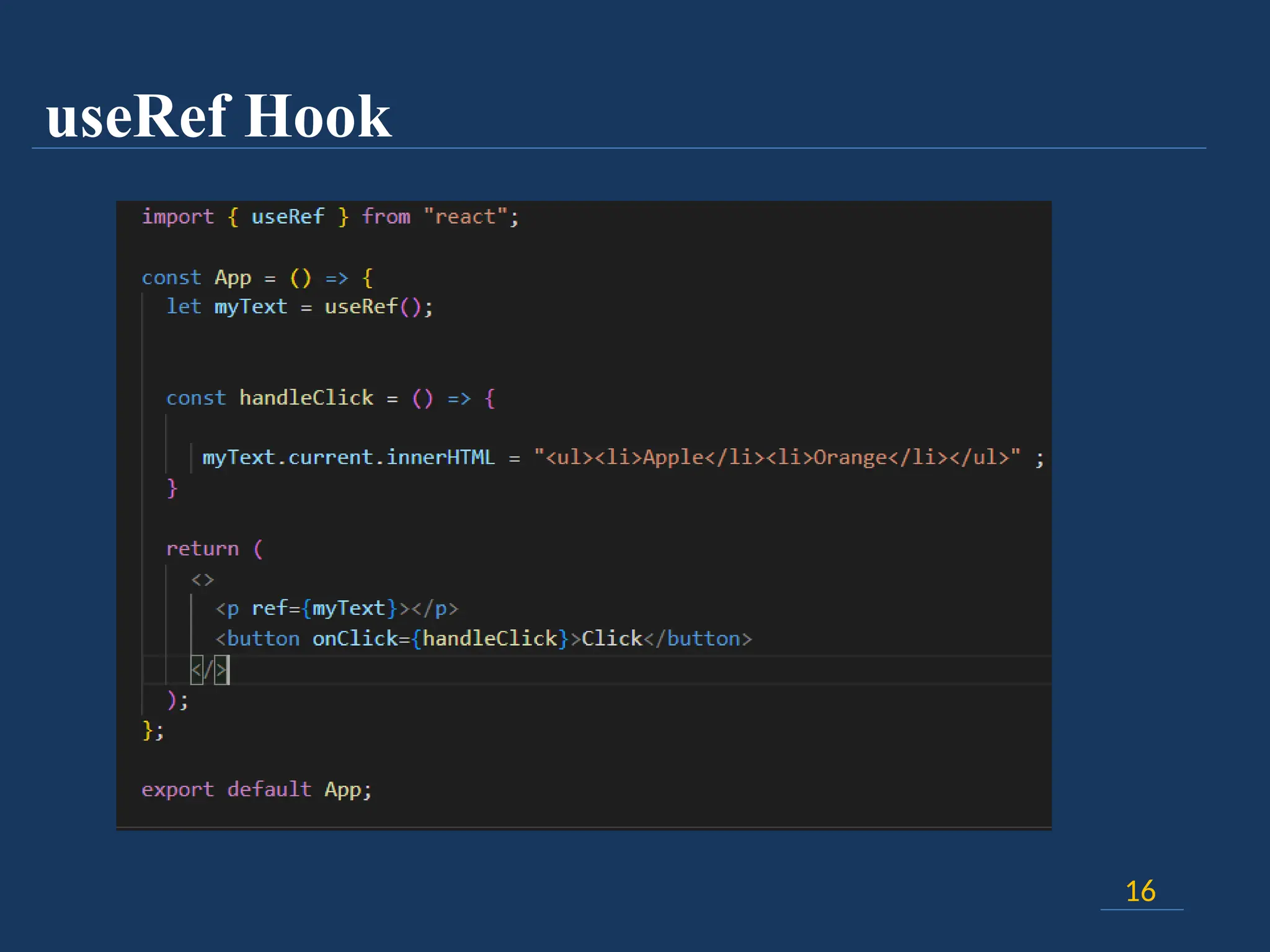
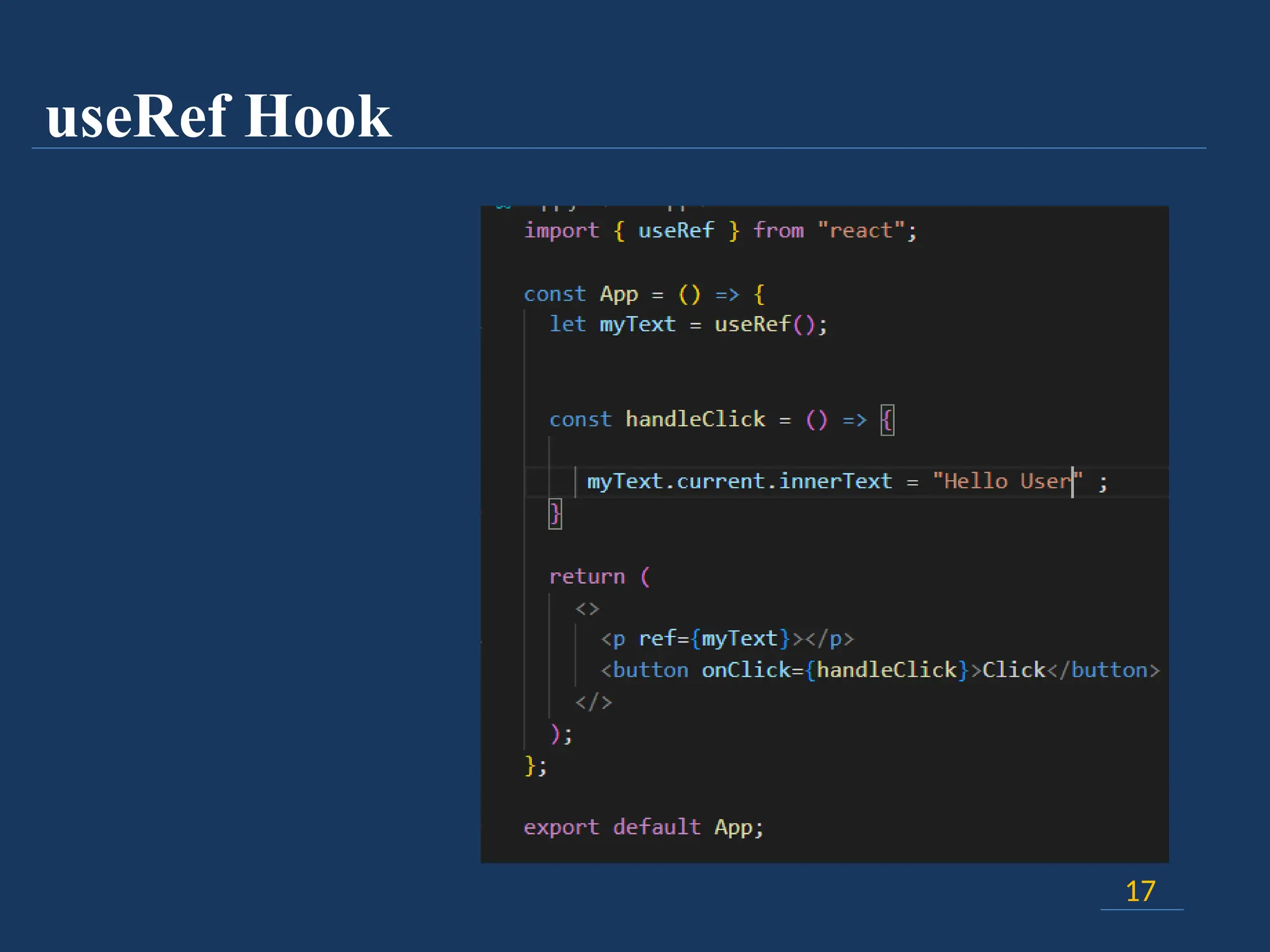
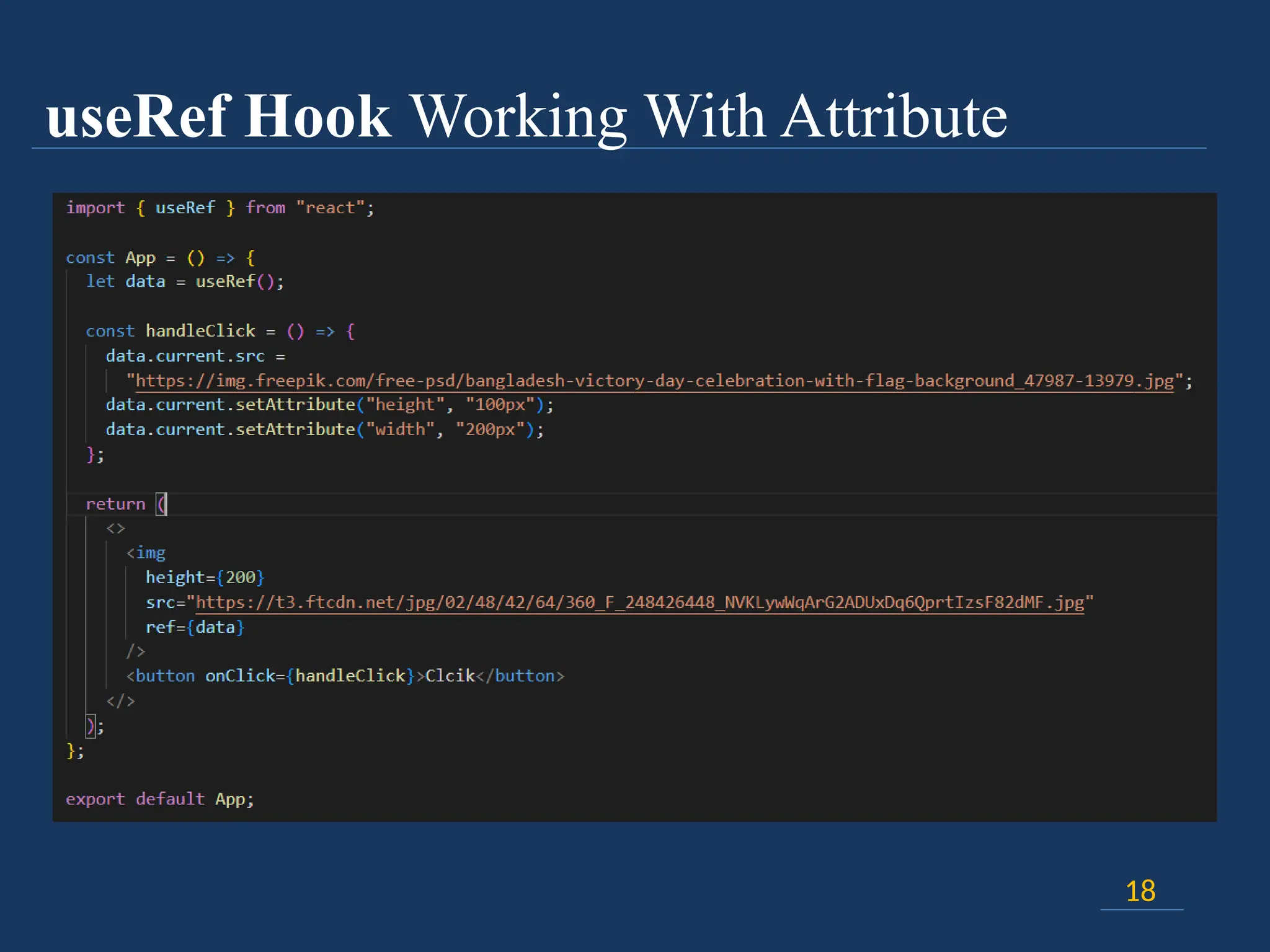
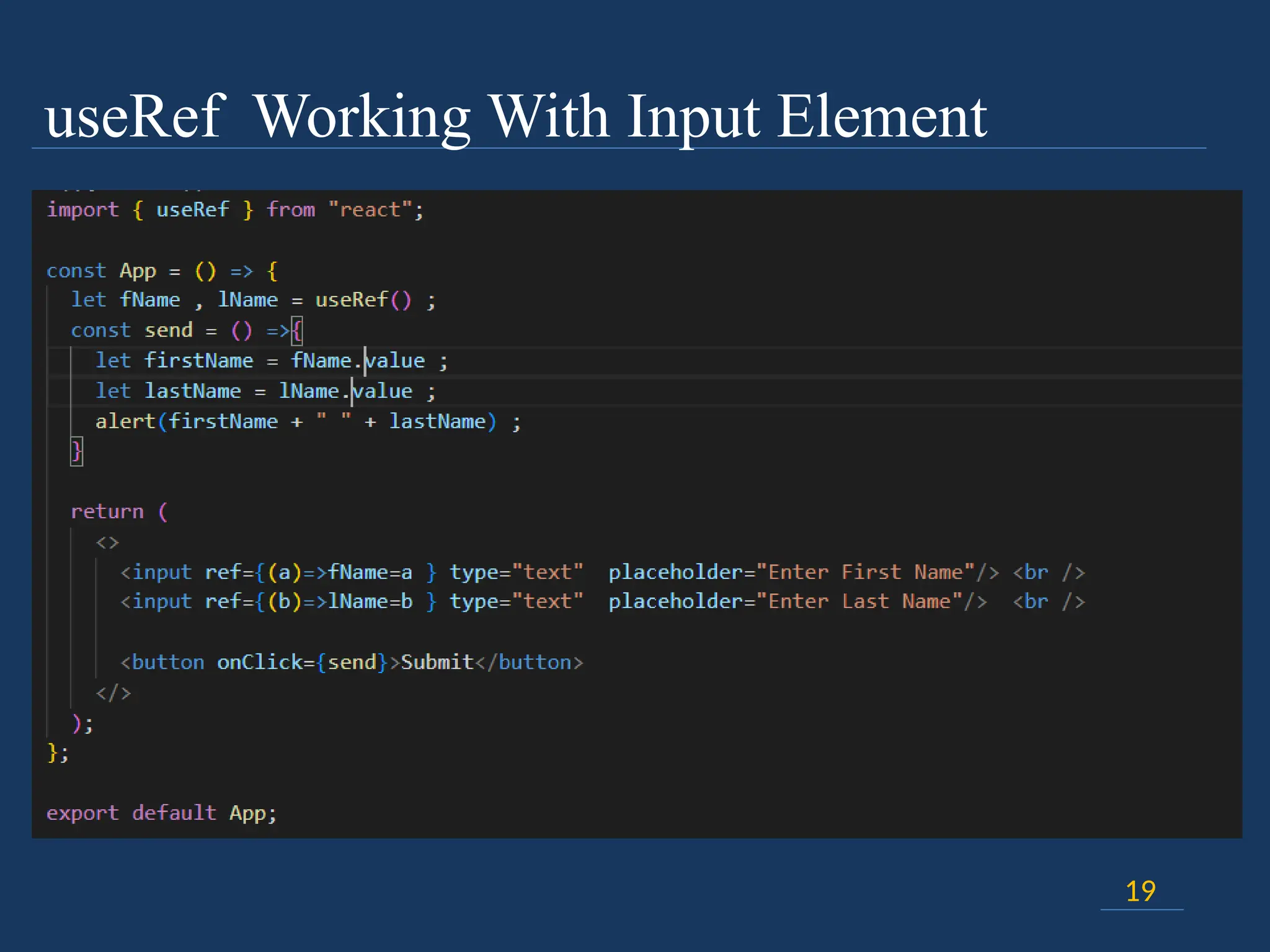
![[Hook] useRef Working With CSS Class
20](https://image.slidesharecdn.com/component-basedjavascriptlibraryinreact-250814194751-e5cea954/75/component-based-JavaScript-library-in-react-pptx-20-2048.jpg)
![[Hook] useRef Working With Persisted Mutable Property
21
The value of mutable property is only
updated
component is not re-rendered](https://image.slidesharecdn.com/component-basedjavascriptlibraryinreact-250814194751-e5cea954/75/component-based-JavaScript-library-in-react-pptx-21-2048.jpg)
![[Hook] useRef Caching Expensive Computation
22
useRef holds a persistent value that survives across renders
but doesn’t cause re-renders when updated
When can use it
When you need to re-use result multiple times without re-rendering
Cache expensive computations
Store previous values
Avoid recalculating something unnecessarily
Preventing reinitialization of complex objects
Where can use it
For API Calling
Avoiding duplicate form submissions](https://image.slidesharecdn.com/component-basedjavascriptlibraryinreact-250814194751-e5cea954/75/component-based-JavaScript-library-in-react-pptx-22-2048.jpg)
![[Hook] useRef Caching Expensive Computation
23](https://image.slidesharecdn.com/component-basedjavascriptlibraryinreact-250814194751-e5cea954/75/component-based-JavaScript-library-in-react-pptx-23-2048.jpg)
![If state change occure then re-render the component
24
The React useState Hook allows us to track state in a function component.
State generally refers to data or properties that need to be tracking in an application
When to Use useState
We need a simple state management solution.
We component has state that changes over time.
The state does not require complex updates or dependencies.
[Hook] useState Understading Inside](https://image.slidesharecdn.com/component-basedjavascriptlibraryinreact-250814194751-e5cea954/75/component-based-JavaScript-library-in-react-pptx-24-2048.jpg)
![25
[Hook] useState Understading Inside
State
Holds all data
view](https://image.slidesharecdn.com/component-basedjavascriptlibraryinreact-250814194751-e5cea954/75/component-based-JavaScript-library-in-react-pptx-25-2048.jpg)
![26
[Hook] useState Understading Inside](https://image.slidesharecdn.com/component-basedjavascriptlibraryinreact-250814194751-e5cea954/75/component-based-JavaScript-library-in-react-pptx-26-2048.jpg)
![27
[Hook] useState Understading Inside](https://image.slidesharecdn.com/component-basedjavascriptlibraryinreact-250814194751-e5cea954/75/component-based-JavaScript-library-in-react-pptx-27-2048.jpg)
![[Hook] useState Working With Immutable Object
28
Immutability : state can’t modify or mutate directly , but
previous object can be change by creating and replacing by new
object
React can’t track prevoius state if you change the state directly
React can’t re-render the component if you change the state directly](https://image.slidesharecdn.com/component-basedjavascriptlibraryinreact-250814194751-e5cea954/75/component-based-JavaScript-library-in-react-pptx-28-2048.jpg)
![29
[Hook] useState Working With Immutable Object](https://image.slidesharecdn.com/component-basedjavascriptlibraryinreact-250814194751-e5cea954/75/component-based-JavaScript-library-in-react-pptx-29-2048.jpg)
![27
[Hook] useState Working With Immutable Object](https://image.slidesharecdn.com/component-basedjavascriptlibraryinreact-250814194751-e5cea954/75/component-based-JavaScript-library-in-react-pptx-30-2048.jpg)
![31
[Hook] useState Working With Immutable Array
don't modify or mutate directly
Make new copy using spread (...) operator
use setState process for update](https://image.slidesharecdn.com/component-basedjavascriptlibraryinreact-250814194751-e5cea954/75/component-based-JavaScript-library-in-react-pptx-31-2048.jpg)
![32
[Hook] useState Working With Immutable Array](https://image.slidesharecdn.com/component-basedjavascriptlibraryinreact-250814194751-e5cea954/75/component-based-JavaScript-library-in-react-pptx-32-2048.jpg)
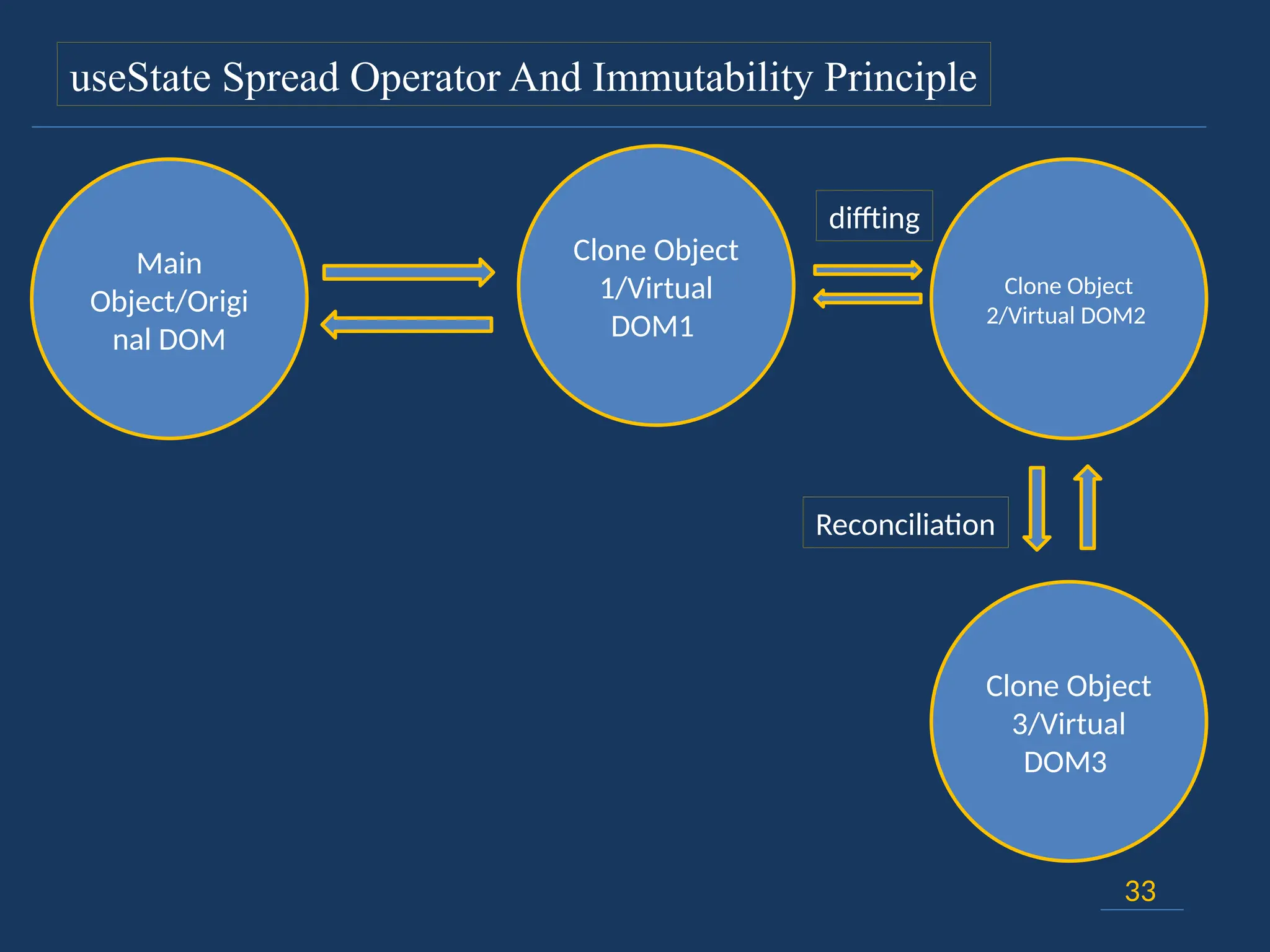
![34
[Hook] useState Working With Immutable Array
The spread operator (...) in React.js is a powerful feature that simplifies working with
arrays and objects, particularly when managing component state.
Used to expand the iterable items , The three dots syntax (...) is used
spread operator (...) is used for cloning, merging, or passing props, arrays, or objects
in a concise and readable way to a component
React state should be immutable . It allows you to create shallow copies of arrays and
objects, making it easier to update them without directly modifying the original data.
It’s a JavaScript feature, not unique to React](https://image.slidesharecdn.com/component-basedjavascriptlibraryinreact-250814194751-e5cea954/75/component-based-JavaScript-library-in-react-pptx-34-2048.jpg)
![35
[Hook] useState Working With Immutable Array
The spread operator helps create new objects or arrays with the desired changes, leaving
the original data untouched.
In React, it's crucial to maintain immutability of state.
Directly modifying state can lead to unexpected behavior and hinder performance
optimizations.
Immutability:](https://image.slidesharecdn.com/component-basedjavascriptlibraryinreact-250814194751-e5cea954/75/component-based-JavaScript-library-in-react-pptx-35-2048.jpg)
![36
[Hook] useEffect understanding arguments and uses
🔸 useEffect Has Two Arguments
1. Callback Function — () => { ... }
This is the function that runs after the component renders.
You perform your side effects here — like calling an API,
setting up intervals, adding event listeners, etc.
useEffect(() => {
console.log("Component mounted");
}, []);
📍 Only runs once, like componentDidMount.](https://image.slidesharecdn.com/component-basedjavascriptlibraryinreact-250814194751-e5cea954/75/component-based-JavaScript-library-in-react-pptx-36-2048.jpg)
![37
[Hook] useEffect understanding arguments and uses
🔸 useEffect Has Two Arguments
2. Dependency Array — [dep1, dep2, ...] (optional)
This array tells React when to run the effect.
React compares the current values with the previous ones
If any dependency has changed, the effect runs again.
If the array is empty ([]), the effect runs only once on mount.
If you omit the array, the effect runs after every render.
useEffect(() => {
console.log("Count changed:");
}, [1]);
📍 Runs every time count changes.
useEffect : perform side effects in function components, like data fetching,
subscriptions, DOM manipulation, etc.](https://image.slidesharecdn.com/component-basedjavascriptlibraryinreact-250814194751-e5cea954/75/component-based-JavaScript-library-in-react-pptx-37-2048.jpg)
![38
[Hook] useEffect understanding arguments and uses](https://image.slidesharecdn.com/component-basedjavascriptlibraryinreact-250814194751-e5cea954/75/component-based-JavaScript-library-in-react-pptx-38-2048.jpg)
![38
[Hook] useEffect understanding arguments and uses promises style
Api Call
Do’t go next step
If previous step fails](https://image.slidesharecdn.com/component-basedjavascriptlibraryinreact-250814194751-e5cea954/75/component-based-JavaScript-library-in-react-pptx-39-2048.jpg)
![38
[Hook] useEffect understanding arguments and uses , async await process
Api Call
Do’t go next step
If previous step fails](https://image.slidesharecdn.com/component-basedjavascriptlibraryinreact-250814194751-e5cea954/75/component-based-JavaScript-library-in-react-pptx-40-2048.jpg)